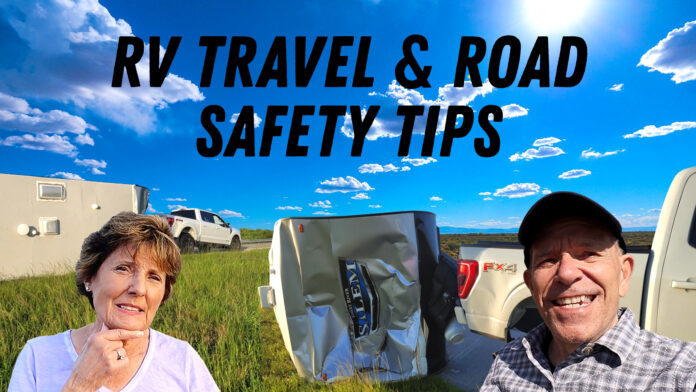We have some really critical RV Safety Tips we need to pass on to you, along with some helpful travel info dealing with National Parks.
We had so much audience feedback this week that all of Episode 407 of the RV Podcast deals with the info we received, along with RV news of the week and your questions.
You can watch the entire video of the podcast on our RV Lifestyle YouTube Channel by clicking the player below.
If you prefer the audio version, you can tune in on your favorite podcast app or click the audio player below.
Podcast: Play in new window | Download (Duration: 44:31 — 26.1MB) | Embed
Subscribe: Google Podcasts | Spotify | Stitcher | Email | TuneIn |
RV News of the Week
Gas prices drop for the sixth week as Americans change their driving habits
Gas prices fell nation-wide for the sixth week in a row, averaging $4.22 a gallon nationally.
Some parts of the country, like California, Oregon, Washington, Illinois, and Maine, have prices as high as $5.61 per gallon, whereas other states such as Texas, Louisiana, and Oklahoma are reporting prices as low as $3.72 per gallon.
New reports state some of the price drop is because Americans are changing their driving habits. Many are driving less, combining errands, carpooling, and canceling vacations.
To see what gasoline prices are averaging across the country click here. To find apps to help you get the best gas prices on the road, click here.
Earth passing by Perseid meteor shower now, with peak coming in about 10 days
One of Jen and my favorite parts of camping is looking up at the stars on a clear, dark night. The view is absolutely amazing. And one of the summer highlights is watching the Perseid meteor shower.
The annual meteor shower will be at its peak Aug. 11-12 this year though there will be some competition from a full moon.
The Perseid meteor shower happens every summer as the earth passes by Comet Swift-Tuttle. This summer the shower started to be visible July 17 and will continue to be visible through Aug. 24 with the highlight Aug. 11-12 when in past years as many as 150-200 “falling stars” per hour can be seen.
For tips on where to find top star gazing spots, click here.
Stargazing
Illegal boondocking along Highway 1 in Big Sur is about to get very expensive
If you are planning on boondocking in California’s Big Sur, make sure you stick to the designated campsites or you may face a hefty fine.
Monterey County is cracking down on illegal camping along California’s epic stretch of Highway 1, and now illegal campers can face fines of $200 to $1,000 per day effective immediately.
Illegal places to camp now include 72-miles of Highway 1 in the Big Sur area along with 3.5 miles along any side road maintained by the county. Officials hope it will address a growing issue of people boondocking illegally in the area.
For more details click here. For tips on how to find places to camp for free, click our article here.
RV Safety Tips – Tamera’s story
RVers face distinctly specific challenges and to meet them, we need as many RV safety tips as possible. One of our followers named Tamera sent us this chilling account of what happened to her this past week and the RV safety equipment that probably saved her.
“We were in a bad accident Friday night 25 miles from our home in Port St. Lucie, Florida. We were traveling on the Florida turnpike when a car traveling at a high rate of speed (at least 100 mph) decided to go between us and a delivery truck.
“Mind you this is 2 lanes!!!
“As they flew past us the excessive amount of air movement caused us to start to sway. We were traveling between 60/65mph when this happened. This caused us to lose control, hit the guard rail and then fish tail back and forth on the road.
“At one point my wife was parallel to the road as we were almost laying on the drivers side. We ended up on the far right side of the ditch.
“The camper never came off of the truck but the camper rolled and ended up in 2 sections. The camper finally came off of the ball a small amount once we came to a stop. Big back wheels elevated a good 3 feet or so in the air.
“The point of all of this is that the police officer and tow truck drivers both said if we had not had our sway bars on we would not have walked away from this accident.
“It’s by the grace of God that we did walk away. I would like to just share so that others use their sway bars as well. I see so many traveling without them.
“Just make sure you use those sway bars!”
RV Safety Tips – Joann’s Story
JoAnn has an important RV safety tip
JoAnn and John Neely from Alabama were two of the attendees at our recent Elkhart Encounter, held last month on the grounds of the RV/MH Hall of Fame. On the first night, John experienced a medical emergency that sent him to the hospital for two days.
Because of medication, he was unable to drive back home. Doctor’s orders. But JoAnn had never before driven the RV.
On the day they were discharged, they returned to our gathering. JoAnn was a nervous wreck about having to drive the RV back. But it just so happened that at that very time, we were having the RV driving school. The instructor, Cortni Anderson, otherwise known as the Flipping Nomad was teaching the session.
Cortni specializes in designing and customizing RV interiors. In fact, she also teaches an awesome online course on RV renovation that we highly recommend. And in fact, we’ll have a whole video about Corni on our RV Lifestyle YouTube Channel in a couple of weeks. But at Elkhart, Corni was the instructor of the RV driving School and Joann took it, even getting a free one-on-one session from Cortni.
Afterward, JoAnn was able to drive their RV home with confidence. She sent us this note, which offers lots of RV Safety Tips every RVer should review.
Corni Armstrong, the Flippin Nomad
From Corni Armstrong, the Flippin Nomad, she learned:
- First, set the side mirrors so that they show 1/3 of your rig and 2/3 of the lane next to you. If you have separate bottom mirrors, set those so they show your tire on the ground.
- Next, always bear in mind, it is going to take far longer to stop your rig than your personal car due to the rig’s weight. You need to go slightly under the speed limit till you get comfortable. Not so slow that you are a road hazard, but slow enough to get stopped.
- Always allow as much distance as you can behind the vehicle ahead. Of course, others are going to cut in, but on that very first drive, you need to be critically observant of what is going on in front of you and beside you, so you have time to react.
- Take a quick break, and walk every hour. Loosen up those tense muscles
From Mike, she learned:
- In the beginning, let merging traffic figure out how to merge in with you. Don’t try to maneuver your driving to make it easier on them.
- On four lane+ roads, stay in the right lane. If passing through a major city, you might want to go one lane to the left to avoid constant oncoming and exiting traffic.
- Stay confident…you can do this!
From Jill, a retired Psychiatrist and Elkhart Encounter attendee, she followed this advice:
- Say over and over…I’ve got this!
And after actually doing the 500-mile drive home herself, she learned:
- It was easier on interstates than state highways or back roads. Wider lanes, less constant traffic.
- I liked going through major cities at rush hour! Others were driving 35-45 versus 65-75! When I moved one lane to the left, I avoided entering and exiting vehicles.
- Most important, don’t wait till you have an emergency like I did. LEARN NOW!
RV Travel Info
Tim and Sarah’s family offer some insider tips for sightseeing at Glacier National Park
Tim and Sarah, two of our California followers, shared this info for those traveling to Glacier National Park. It also applies to other National Parks, where getting an entry pass can be a challenge.
Tim and Sarah said this about a very popular RV destination:
“We just got back from a month-long RV trip with our family where our destination was Glacier national park!!’ It was absolutely incredible.
There were a few challenges that we faced and I thought maybe it would be good for the RV community to know how to get around these challenges at Glacier.
First of all, they are requiring a timed entrance for your vehicle. These are given away every day at 8 AM and there are only 151 spots available. From what I understand, there are about 1500 people trying to get these spots every day.
Also, I heard that there are travel agencies that are swooping in and grabbing a ton of those spots. Because of this, we were there for a week and never were able to get an entrance for our vehicle. But all was not lost.
We found a way around it.
If you’re in Glacier and you don’t get a vehicle pass this is what you do: first of all, you can go into the park before 6 AM and be there all day. Second of all, you can also go into the park after 4 PM. Montana right now does not get dark until about 10:30 PM so that gives you plenty of time to enjoy going to the Sun Road and any of the hiking trails.
There is one more way around it. If you get yourself a reservation for anything, then you can go in during the day. Reservations include a boat ride, a kayak rental, or any kind of tour. Even though we never were able to get a reservation for our car, we were still able to do everything we wanted to do by using these different techniques.”
The Kindness of other RVers
Dave from Waterford, MI, wanted to share the kindness of other RVers when he and his wife suffered a breakdown on the road:
“My wife and I purchased our first travel trailer about a year ago. I have been learning a ton from your website and podcasts during the last year. We took our first real trip last week up to the Leelanau Peninsula.
We had a great time until our truck broke down on the trip home just outside Traverse City.
We were forced to have our truck towed to a dealer. We were not sure exactly what we were going to do with our trailer that was sitting on the shoulder of M-72.
While we waited for the tow truck, we had 4 different groups of people stop (all campers) and offer to help us. One couple offered, and we agreed to allow them to tow our trailer to a nearby casino parking lot while we dealt with the truck.
“The breakdown was definitely frustrating, but the kindness of all of the campers that offered to help made a bad situation much better.“
Mike and Jennifer’s Summer T-Shirts for your next adventure
Your Adventure Awaits! New colors and designs are waiting for you.
RV Questions
We answered the following questions this week. The detailed answers can be heard on the podcast. But we’ll summarize our responses.
Question: I’m new to the RV lifestyle. Was wondering when storing my RV for a few weeks in between outings should I leave my black tank empty or full with clean treated water? – Robert
Answer: No matter how much you empty it – unless you flush it out with a high-pressure wand or black take flusher, as they’re called – those tanks will still have some residual matter in them. It will likely dry and coat the walls of the tank, the sensors and the bottom. And it will stink.
After the back tank has been dumped and is relatively empty of all human waste, we recommend that you store your RV with a black tank full of fresh water and a treatment of a high-quality product that fights bacteria and enzyme like Happy Camper or RV Digest-IT that has thoroughly dissolved in the water.
You want to be sure and not just leave untreated water in the black tank. That’s because even with clean water, there is enough residual matter in that tank to throughly contaminate it.
When you take the RV out of storage and before you start traveling again, be sure to empty the black tank again. Then put a couple gallons of clean water in, treat it, and start on your way. Remember water is the best friend you have in keeping your black tank odor free.
Mike and Jennifer’s RV Lifestyle hat collection
Who needs a hat?
Who needs a hat? You do! Dad hats aren’t just for dads. This comfy one’s got a low profile with an adjustable strap and curved visor. Just the thing to wear on your next RV Lifestyle adventure.
Question: We are questioning what practical uses and experiences you’ve had with ham radio and the “on the move” RV lifestyle. We have been thinking of outfitting our truck w/ mobile VHF 2m and UHF 70cm & carrying two dual-band HTs. More specifically, do you find it useful for mining tips from locals coming into a new area? Or do you find it a more efficient usage of time to mostly rely on traditional RV planning tools (including internet searches and reviews, phone app info) and word of mouth in the new area? – Jim and Pam
Answer: Frankly, we have found amateur radio to offer no real practical value in learning about an area, being informed of highway and traffic issues or alternate routes. RV planning apps do a much better job than ham radio. And GPS is the best way to find alternate routes.
That said, ham radio is fun and entertaining but frankly, cell phones and GPS systems are more practical. As emergency backup communications if the cellular network failed for any reason, I find it a great safety blanket. Some hams love to do all sorts of technical things with it, like sending alerts to other hams on where they are.
But in real, day-to-day practical use, there are better ways to do that. Unless all other ways of communication fail. I always have it with me. I just don’t use it that much, except for pure hobby purposes from time to time.
Question: I’m looking to purchase a used RV and sell mine. Can you recommend an online site to research RVs by VIN number? I have googled and found several sites but they all ask for payment which I wouldn’t mind but I don’t want to give my credit card number on any website. So I’m wondering if you know of a reputable site that can give me that kind of information. – Elaine
Answer: There are indeed a lot of pay-for-use sites that lure you in thinking it to be free but then want to charge you a fee or make you sign up for a membership to get the results.
But there are three free ones we can recommend. They are good for searching the VIN number on cars, trucks, all classes of RVs and towables.
VehicleHistory.com is a comprehensive resource. from theNational Highway Traffic Safety Administration (NHTSA). It returns information on recalls for that VIN.
The NHTSA Recall Database tracks vehicles that have a VIN number and also shows if there are any open recalls that have not been repaired.
The NICB VINCHECK database tracks vehicles that were stolen, salvaged or reported as a total loss by an Insurance Company who is a member of the National Insurance Crime Bureau.
New ebook from Mike and Jennifer Wendland – the Natchez Trace
The Natchez Trace Parkway will capture your imagination, soothe your jangled travel nerves, open your mind and inspire you with the history that unfolded along its 444 miles.
Each of the 7 Days of the ebook has:
- Suggested Mileposts to explore
- Places to Eat in each area of the 7 sections
- Campground descriptions and links
- Links to all the special places and information
- Links to videos that show more in detail
- and a lot of highlighted information for each section
PLEASE NOTE: This is NOT a printed, hard copy guide.
Whether you want to follow the footsteps of explorers, discover natural beauty, or visit historic sites, the Trace has something to grab your attention and leave you eager to see what’s at the next milepost.
You can see why this is one of our favorite US routes to explore. We’ve traveled it a half dozen times!
Escape the ordinary and discover the extraordinary! From bustling cities to serene landscapes, every journey begins with a single step—let us guide yours. Enjoy curated itineraries, hidden gems, and hassle-free bookings designed for explorers at heart. Whether it's a weekend getaway or a globe-trotting adventure, your Next unforgettable experience is just a click away.










